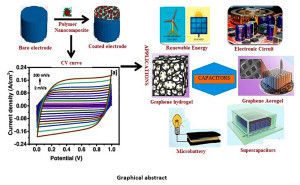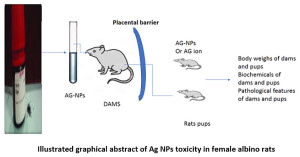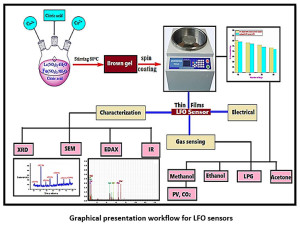Zinc Versus Magnesium as Biodegradable Metals for Temporary Implants
Pages : 01-04Manoj Gupta
Manoj Gupta
Udayan De
Sameena Mahtab1 , Pragati Joshi1, Bhagwati Arya1, M.G.H. Zaidi1*
, Pragati Joshi1, Bhagwati Arya1, M.G.H. Zaidi1* and Tanveer Irshad Siddiqui2
and Tanveer Irshad Siddiqui2
We have reviewed recent progress on various types of humidity sensors as it is one of the most significant issues in various areas of sensing appliances such as instrumentation, charge storage automated systems, industries and agriculture. Various effective approaches have been discussed to develop ceramic, semiconducting and polymer based graphite sensors. It was found that graphite based nanocomposite materials have unique potential for detecting humidity due to specific structure, high electrothermal conductivities, good mechanical properties, low cost and ultrahigh surface area that increases applications in the field of energy storage devices.
Graphical Abstract
 Click on image to enlarge |
CNT based material are of vital importance in modern technology for their superior physical and chemical properties. In recent times, materials development for energy applications is focused for improvement of battery, capacitors, and electrodes for enhanced efficiency. High performance Supercapacitors with high energy densities are at the leading edge for renewable energy engineering device sector. CNT based Ni-Co-O material is of keen interest due to its possible applications as supercapacitors, electrocatalyst for metal/air battery and others. The hybrid material synthesis, morphological and electrochemical features are vital to evaluate the material performances for energy applications. Electrical studies are also important to evaluate the properties required for device applications. CNT is used as electrode material for electrochemical storage due to superior chemical stability, low mass density, low resistivity and large surface area. CNT replaces activated carbon material as supercapacitor due to improper balance between enhanced surface area and mesoporosity thus limiting electrolytic accessibility and capacitance. In the present article a brief review is stressed forward for the development of CNT-Ni-Co-O based hybrid material for supercapacitor high energy density applications.
Paroma Arefin1* , Md Shehan Habib2
, Md Shehan Habib2 , Aishawarya Arefin3
, Aishawarya Arefin3  and Md Saidul Arefin3
and Md Saidul Arefin3
Smart canes are one of the mobility assistive devices to facilitate the freedom of movement and help people with mobility problems to move around and perform daily chores, which are not possible usually. But they are available in different design options to offer specific advantages. In this review paper, we have addressed different mechanical and electronic designs of assistive devices proposed and developed by various researchers. The aim of our study was to sort out different mechanisms of actions used by them. With the discussion and comparison of their mode of functions, we have found a direction to potential future improvements, development, and variations to fulfill individualized and customized requirements.
Mohammad K. Dmour1, Eman S. Al-Hwaitat1, Ibrahim Bsoul2 and Sami H. Mahmood1,3*
and Sami H. Mahmood1,3*
Rare earth substituted W-type hexaferrites were prepared by mixing and ball milling starting powders with molar ratios consistent with the stoichiometry of Ba1-xRexCo2ZnxFe16-xO27 (Re is a rare-earth element; x = 0.1 and 0.2), pelletizing, and sintering 1300° C. X-ray diffraction patterns showed a pure W-type phase in all samples, except in the Nd-Zn (x = 0.1) substituted sample which revealed the presence of an impurity α-Fe2O3 nonmagnetic phase. The crystallization of the W-type phase in all samples was further confirmed by the characteristic Curie temperature ranging between 476° C and 484° C as revealed by the thermomagnetic measurements. Scanning electron microscopy imaging revealed the variations of the particle size and morphology, and porosity of the prepared samples. The magnetic measurements indicated that the RE–Zn substitution improved the saturation magnetization slightly relative to the un-substituted Co2W hexaferrite, and resulted in a decrease of the coercivity and magnetocrystalline anisotropy field. In addition, the peaks below 300° C in the thermomagnetic curves is an indication of the occurrence of spin reorientation transitions in the prepared hexaferrites.
Sumarji , Mochamad Gerindo Dwi Aqsho, Hari Arbiantara Basuki
, Mochamad Gerindo Dwi Aqsho, Hari Arbiantara Basuki , Mochamad Asrofi*
, Mochamad Asrofi*
This study examines the effect of addition rice starch particle (RSP) in Polyethylene terephthalate (PET) based blend composites. The concentration of RSP in PET was varied at 0, 5, 10, 15 and 20 wt% with fixed percentage of sorbitol for 2 ml. The blend composites were produced by solution mixing method. All samples were tested by tensile and morphological observation after tensile test. The tensile test proves that the addition of RSP in PET increased tensile strength of blend composites. The maximum tensile strength was in 15 wt% RSP in PET for 9.79 MPa. Optical microscope displays minimum porosity with good fusion between RSP and PET. The addition of starch in polymer is suggested to reduce the percentage of using non-biodegradable polymer plastic. This research is important due to the development of biodegradable polymer.
Mahmoud M. Elalfy1* , Mamdouh Abouelmagd1, Eman A. Abdelraheem1 and Mona G. El-hadidy2
, Mamdouh Abouelmagd1, Eman A. Abdelraheem1 and Mona G. El-hadidy2
Silver nanoparticles (Ag-NPs) had many uses in medicine, household and industry. To better understand the postnatal toxicity of Ag-NPs in lactating female rats and its offspring’s, 18 female rats after delivery were divided into three groups and dams received orally the AG-NPs at doses of 0, 50, 100 ppm daily for 21 days. After the end of treatment, all rats were euthanized and blood and tissues were separated for evaluation of biochemical and histopathology in dams and its pups. The Ag-NPs had no effect on the dam's weight while the reduction of rats’ pups weight was noticed after first week only after the treatment. Notably, Ag-NPs had toxic effects in rat’s pups, as well as its dam with evidence of elevation of liver enzymes, urea, creatinine and reduction of serum protein, albumin and globulin and considered the first report explained the toxicity in the rat’s pups. Moreover, rats' pups revealed histopathological changes in liver and kidney as well as its dams. Notably, the nano-silver is considered cytotoxic for HepG2 cell line as well as mouse liver cell line. In conclusions, the Ag-NPs considered toxic in offspring as well as dams and had immunosuppressive effects in the postnatal model of toxicity as well as cytotoxicity to hepatic cells lines.
Illustrated graphical abstract of Ag NPs toxicity in female albino rats
 Click on image to enlarge |
To realise the miniaturised devices, the precise measurement of nanoscale tunnelling current in ultrathin films is of utmost importance. For the nanoscale current measurements, current sensing atomic force microscope (CSAFM) is one of the most powerful tool. CSAFM allows to map the current distribution on the film surface and it permits to perform current measurements as a function of applied bias voltage. It has turned out to be crucial for studies of organic films. In CSAFM, a physical contact is made on film with a precise control of the applied force in nanonewton (nN) range. For the preparation of ultrathin film, Langmuir-Blodgett (LB) technique is known to provide a uniform film with a good control over the thickness in the molecular level. In the last two decades, there have been many CSAFM studies for the tunnelling current measurements. This review is intended to cover the literature on the tunnelling current measurements using CSAFM.
Prashant Bhimrao Koli1* , Kailas Haribhau Kapadnis2, Uday Gangadhar Deshpande3, Balaji pandurang More1 and Umesh Jagannath Tupe4
, Kailas Haribhau Kapadnis2, Uday Gangadhar Deshpande3, Balaji pandurang More1 and Umesh Jagannath Tupe4
In this investigation we are reporting the rapid preparation of Perovskite LaFeO3 thin films prepared by sol-gel synthesis followed by spin coating method. The structural properties of the spin coated LaFeO3 thin films measured by X-ray Diffractometer which confirms the formation of monophasic, orthorhombic, Perovskite LaFeO3 material. The morphological features of the films were explore by the ease of scanning electron microscopy, where the crystalline LaFeO3 nanoparticles were observed. Energy dispersive spectroscopy was utilized for the determination of elemental composition. The electrical properties were carried out to confirm the typical semiconducting behaviour of LaFeO3 p- type semiconductor. The thin films were subjected for gas sensing study, the material was found to be very efficient gas sensors for LPG, petrol vapour, CO2, methanol, ethanol, acetone gases. The main object was to discuss comparative study, means, what changes in parameters may be observed due to doping elements. Here undoped LFO sensor showed excellent sensitivity to methanol vapours, while doped LFO sensors found to very sensitive for petrol vapours. The enhanced sensitivity by doped LFO may attributed to increase surface area due to dopants.While all parameter essential for effective sensor were investigated in detail like, response recovery, reusability, selectivity of both the sensors.
Graphical presentation workflow for LFO sensors
 Click on image to enlarge |